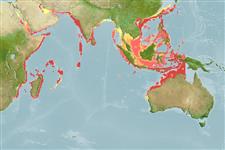Preferred temperature (Réf.
123201): 24.7 - 29.2, mean 27.3 °C (based on 386 cells).
Phylogenetic diversity index (Réf.
82804): PD
50 = 0.5000 [Uniqueness, from 0.5 = low to 2.0 = high].
Bayesian length-weight: a=0.00977 (0.00574 - 0.01664), b=3.00 (2.86 - 3.14), in cm total length, based on LWR estimates for this species & Genus-body shape (Ref.
93245).
Niveau trophique (Réf.
69278): 3.9 ±0.66 se; based on food items.
Generation time: 4.1 ( na - na) years. Estimated as median ln(3)/K based on 2
growth studies.
Résilience (Réf.
120179): Milieu, temps minimum de doublement de population : 1,4 à 4,4 années (K=0.27).
Prior r = 0.57, 95% CL = 0.37 - 0.85, Based on 1 data-limited stock assessment.
Fishing Vulnerability (Ref.
59153): Moderate vulnerability (39 of 100).
🛈
Climate Vulnerability (Ref.
125649): Very high vulnerability (82 of 100).
🛈
Nutrients (Ref.
124155): Calcium = 19.7 [9.8, 42.9] mg/100g; Iron = 0.456 [0.240, 0.931] mg/100g; Protein = 18.7 [17.2, 20.1] %; Omega3 = 0.12 [0.07, 0.19] g/100g; Selenium = 48.1 [27.5, 89.1] μg/100g; VitaminA = 106 [30, 362] μg/100g; Zinc = 1.01 [0.71, 1.45] mg/100g (wet weight);
